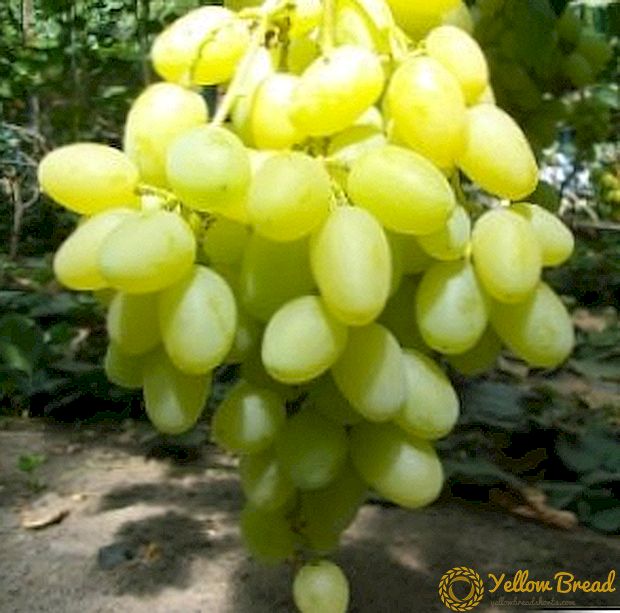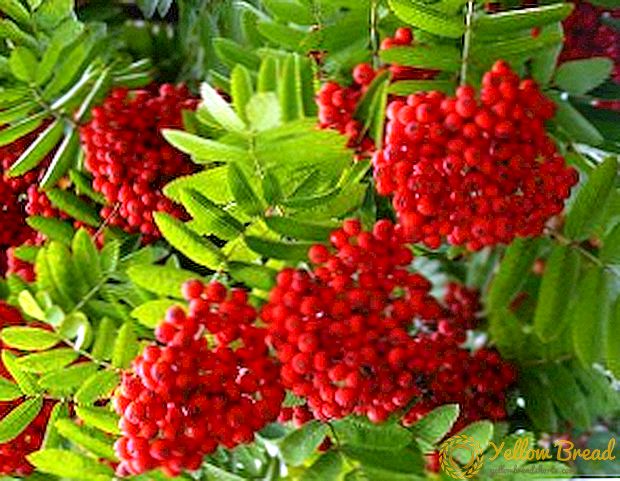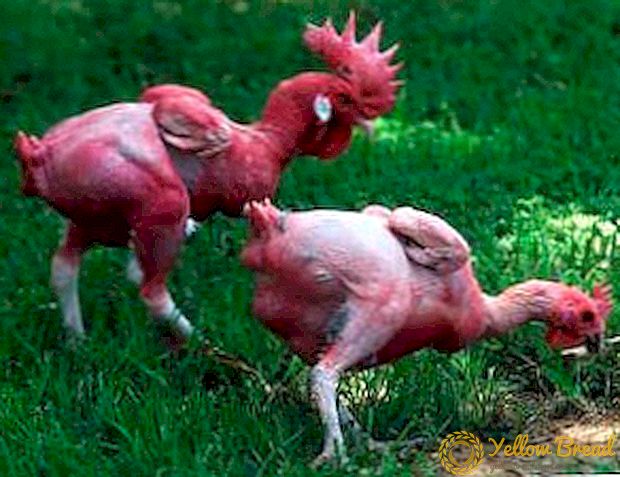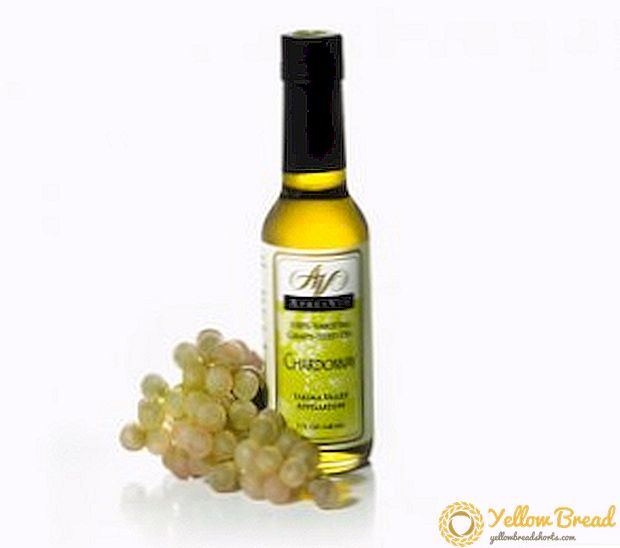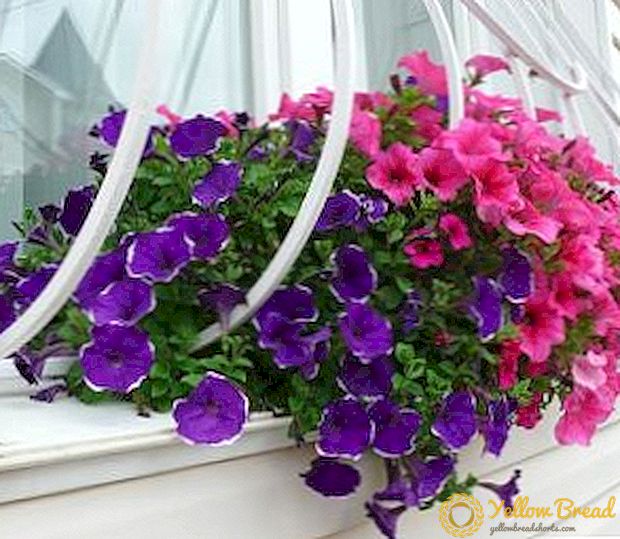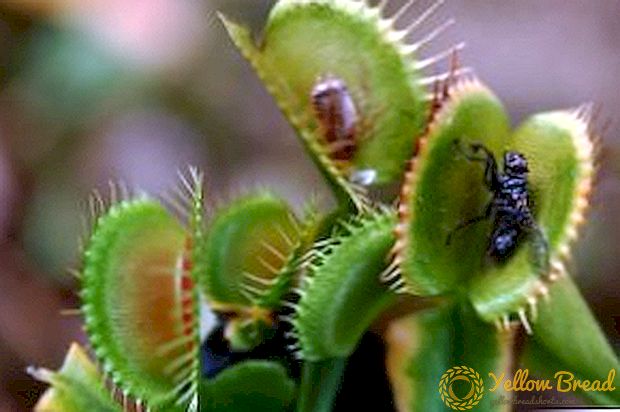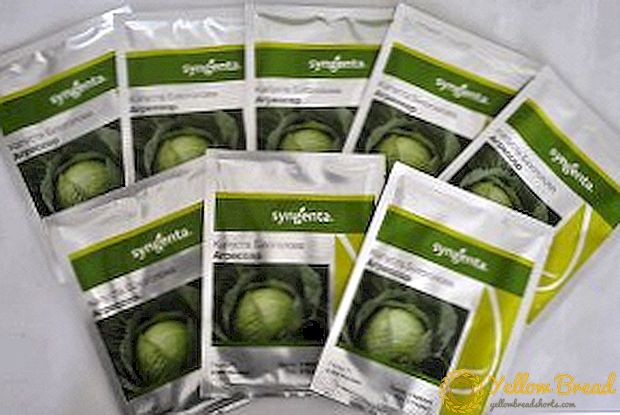
Cabbage "Aggressor" - quite young variety, characterized by resistance to weather conditions, good taste and excellent yield. In this article we will give a description of this plant, describe its advantages and disadvantages, and also consider the rules of planting and care.
- Description of cabbage varieties "Agressor"
- The advantages and disadvantages of the variety
- Growing seedlings
- Landing features
- Plant care
- Diseases and pests
- Harvesting
Description of cabbage varieties "Agressor"
Variety "Aggressor" was bred in 2003 in a Dutch breeding company. This is a hybrid mid-season cabbage. Has a high sheet outlet. Sheets are medium in size, rounded, dark green or gray-green in color, with slightly wavy edges.
 On the surface, waxing is well traced. Heads flattened, dense. The incision is observed white with a slight yellow tint. The length of the stalk is 16-18 cm. On average, the weight of one head can reach 3-5 kg. This variety brings excellent yield - about a ton from one hundred square meters.
On the surface, waxing is well traced. Heads flattened, dense. The incision is observed white with a slight yellow tint. The length of the stalk is 16-18 cm. On average, the weight of one head can reach 3-5 kg. This variety brings excellent yield - about a ton from one hundred square meters.
The plant is characterized by a strong root system. It has a pleasant taste, juicy and crispy leaves. Used for fermentation, and for the preparation of salads.
The advantages and disadvantages of the variety
Despite the fact that cabbage varieties "Aggressor" has already come to many liking, along with positive qualities, it has a number of negative characteristics.

The advantages of "Aggressor" include the following:
- unpretentiousness to growing conditions (grows even on poor soils);
- normally bears waterlessness, does not require constant watering;
- seed germination - 100%;
- nice appearance, which makes it possible to use for sale;
- suitable for transportation;
- can be stored for about 5 months without losing its properties;
- resistance to cracking, as well as to many pests.
Disadvantages:
- rough sheets;
- when salting can give a bitter taste;
- subject to whitefly and aphid attacks;
- often suffers from fungal diseases, the most serious - kila.
Growing seedlings
You can grow cabbage seedlings both in indoor conditions and in the garden.
First you need to prepare the seeds. For planting choose only those whose size is not less than 1.5 mm. Then the seeds are immersed for 20 minutes in sufficiently warm water (about 50 ° C) to kill various bacteria. After that, they are placed for 2-3 minutes in cool water and dried.
Sown in early April. Pots 7-8 cm in depth are best suited. A mixture of soil, peat and sand is taken as the soil. Planted seeds to a depth of 1 cm, the distance between them - 3 cm. The first shoots are shown in 5-7 days.
The best place to keep the seedlings is the windowsill, where it is light and the temperature reaches 15-18 ° C. It is also recommended to take the pots outside for quenching during the day if the temperature does not fall below 6-8 ° C. At night, cabbage is taken into the house.

As soon as two leaves are formed, you can make the first feeding. The second is paid 12-15 days later, and the third - a couple of days before transplanting to the garden.
If the seeds are sown directly in the garden, then you need to wait for the end of April. The territory is chosen well illuminated by the sun.Before sowing, the earth needs to be enriched with nutrients, you can make diluted humus. Seeds are placed in the ground at a depth of 1 cm. As a rule, 2-3 pieces are placed in each hole. Be sure to cover the bed with a film to provide warm young shoots.
Among the formed sprouts, they choose a stronger one, and the rest are removed or transferred to another place.

Landing features
After 35-40 days of growth of seedlings it can already be moved to open ground. To do this, you need to make small holes, you can also immediately make dressing from humus, sand, peat and wood ash. Water is poured into the hole (0.5 l) and the seedling is deepened only up to the first leaf.
Cabbage is planted at a distance of 50-70 cm between the bushes and 60 cm between the rows, since this variety needs a large area for vigorous growth.
Plant care
Cabbage varieties "Aggressor" - moisture-loving vegetable, so it needs abundant watering. After planting for 14 days, watering is done once every 3 days, then reduced to once a week (about 10 liters of water per 1 square meter). It is important that the water is at room temperature, as cold is harmful to the plant.  An important process for intensive growth is hilling, which is done on the 20th day after disembarking. This helps to strengthen the plant and the appearance of additional roots. It is also necessary to regularly loosen the ground after each watering and remove weeds.
An important process for intensive growth is hilling, which is done on the 20th day after disembarking. This helps to strengthen the plant and the appearance of additional roots. It is also necessary to regularly loosen the ground after each watering and remove weeds.
It is good in the first days to sprinkle a bed of ashes - this will help scare slugs away from immature vegetables.
Favorable effect on cabbage fertilizer. This is mainly done 3 times over the entire growth period:
- 20 days after disembarkation - 0.5 liters of mullein per 10 liters of water. On one bush has 0.5 liters of the mixture.
- 10 days after the first feeding in the same way.
- In early June - 2 tbsp. l mineral fertilizer on a bucket of water. For 1 square meter requires 8 liters of fluid.

Diseases and pests
Despite the fact that the "Aggressor" is resistant to many diseases, there are still parasites, capable of harming him:
- Cabbage Mole - there are holes and eggs on the back of the sheet. Calcium arsenate or chlorophos solution is suitable for treatment.
- Cabbage Aphid - leaves become pink. Get rid of wiping the leaves with a rag dipped in soapy water or milk.
- Cabbage Fly - damages the roots, making moves in them. Use a mixture of tobacco per 1 square meter (1 tbsp.l.), wood ash (10 g) and red pepper (1 tsp.)
- Rapeseed Bilan - eats sheets, lays eggs. Apply the same as for the cabbage moth.
- Snails and slugs - damage sheets, leave a specific trace. Under each bush to put the pellets of the drug "Thunder" or "Meta" (3-4 pieces).


Diseases to which this variety is exposed:
- Quila - a fungal disease, as a result of which the plant fades, changes color. On roots grows, contributing to decay. The most common method of struggle is to remove infected bushes, and before planting the roots are treated with a clay solution.
- Blackleg - darkening of the root collar and stem base, their rotting. Before planting the plants in the ground, the roots are immersed in a solution of clay with potassium permanganate.
- Downy mildew - the appearance of yellow spots and gray plaque on the leaves. For processing using a 1% solution of Bordeaux liquids.
Harvesting
3 weeks before harvesting, cabbage is no longer watered, allowing cellulose to accumulate. That it contributes to good storage. They are collected at the end of September - beginning of October, when the night air temperature ranges from 0 to -2 ° C. Clean the cabbage in dry weather with a sharp knife.  It is imperative to leave a stalk 3-4 cm long and a pair of upper leaves so that the vegetable can take nutrients from there. Immediately it is necessary to separate the damaged heads and send them for recycling, since only completely healthy plugs can be stored. Before being placed in the cellar, cabbage is kept under a canopy for 24 hours, allowing it to dry.
It is imperative to leave a stalk 3-4 cm long and a pair of upper leaves so that the vegetable can take nutrients from there. Immediately it is necessary to separate the damaged heads and send them for recycling, since only completely healthy plugs can be stored. Before being placed in the cellar, cabbage is kept under a canopy for 24 hours, allowing it to dry.
The optimum temperature for storage is + 1 ... + 6 ° С, and the humidity of the air is no less than 90%. The heads are kept in wooden boxes or folded in several rows, just not on the floor. Forks can also be tied up to the ceiling, thus ensuring good ventilation. Some gardeners wrap them with paper and put them on the shelves, or completely put them in a bucket of sand.
 Growing cabbage varieties "Aggressor" is easy enough, because it is undemanding in the care and resistant to adverse conditions. It also has excellent taste and can be stored for a long time.
Growing cabbage varieties "Aggressor" is easy enough, because it is undemanding in the care and resistant to adverse conditions. It also has excellent taste and can be stored for a long time.

